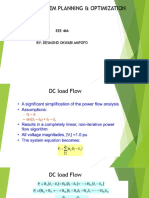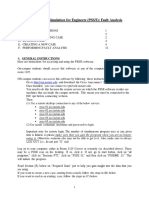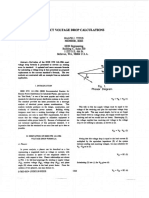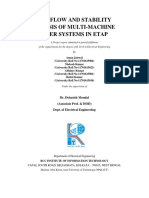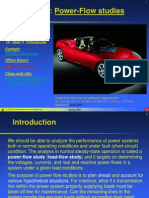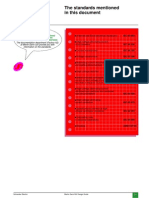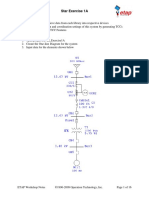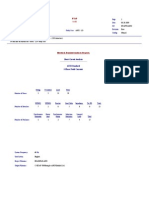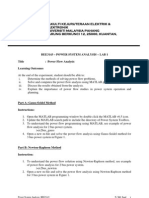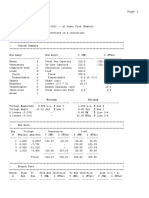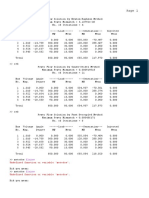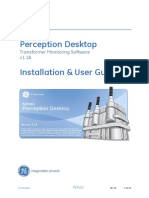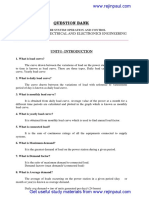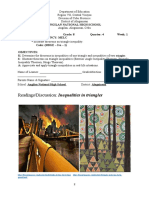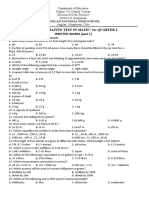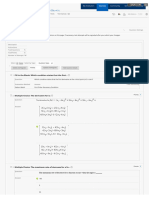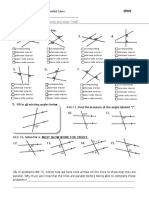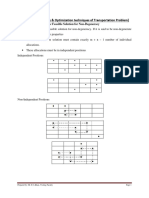qwertyuiopasdfghjklzxcvbnmqwerty
uiopasdfghjklzxcvbnmqwertyuiopasd
fghjklzxcvbnmqwertyuiopasdfghjklzx
Power flow Analysis
cvbnmqwertyuiopasdfghjklzxcvbnmq
Loud FLOW SOLUTION
wertyuiopasdfghjklzxcvbnmqwertyui
opasdfghjklzxcvbnmqwertyuiopasdfg
Prepared to
hjklzxcvbnmqwertyuiopasdfghjklzxc
Dr. Emaad Sedeek
vbnmqwertyuiopasdfghjklzxcvbnmq
wertyuiopasdfghjklzxcvbnmqwertyui
opasdfghjklzxcvbnmqwertyuiopasdfg
Prepared by
Ahmed Raafat Ahmed
hjklzxcvbnmqwertyuiopasdfghjklzxc
vbnmqwertyuiopasdfghjklzxcvbnmqwe
rtyuiopasdfghjklzxcvbnmqwertyuiop
asdfghjklzxcvbnmqwertyuiopasdfghj
klzxcvbnmrtyuiopasdfghjklzxcvbnmq
wertyuiopasdfghjklzxcvbnmqwertyui
opasdfghjklzxcvbnmqwertyuiopasdfg
� 2011 Power flow Analysis
1. Gauss iterative Routine Method using [Y] Matrix
1 (S T i ) * n
Vi Y ijV i
Y ii (
V i ) * j 1
i 1
i. Construct [Y] matrix
y 11 y 12 y 13
Y= y 21 y 22 y 23
y 31 y 32 y 33
ii. Initial Assumption
V 20 V 30 1 0o
iii. Calculation transmitted
Power
S Tsch2 S gsch2 S Ld
sch
2 S sch
g2
2
� 2011 Power flow Analysis
S Tsch3 S gsch3 S Ld
sch
3 S sch
g3
iv. 1st iteration:
V 21 Voltag at bus(2) due to 1st iteration
1 (S Tsch2 ) * 0
V 2
1
( y V
21 1
sch
y V
23 3
Y 22 (V 20 ) *
1 (S Tsch
3 )* 0
V 31 ( y 31V 1 y 32V 3
sch
Y 33 (V 30 ) *
v. 2nd iteration :
1 (S T1 2 ) * 1
V 2
2
( y V
21 1
sch
y V
23 3
Y 22 (V 21 ) *
1 (S T1 3 ) * 1
V 32 ( y V
31 1
sch
y V
32 3
Y 33 (V 31 ) *
vi. Calculation of complex power
S 1
g1 S sch
Ld 1 S 1
T1
S g1 1 V 1sch y 11V 1sch y 12V 21 y 13V 31
2. Gauss iterative Routine Method using [Z] Matrix
V 2 V 1 z 22 z 23 I 2 y 20V 1
V V z z 33
3 1 32 I 3 y 30V 1
3
�2011 Power flow Analysis
i. Construct [Y] matrix
y 11 y 12 y 13
Y= y 21 y 22 y 23
y 31 y 32 y 33
4
� 2011 Power flow Analysis
ii. Matrix ref. to bus one
y 22 y 23
Y
y 32 y 33
iii. Matrix ref. to bus one
Z 22 Z 23
Z
Z 32 Z 33
iv. Initial Assumption
V 20 V 30 1 0o
v. Calculation transmitted Power
S Tsch2 S gsch2 S Ld
sch
2 S sch
Ld 2
S Tsch3 S gsch3 S Ld
sch
3 S sch
Ld 3
vi. 1st iteration:
V 21 Voltag at bus(2) due to 1st iteration
V 21 V 1sch z 22 (I 20 y 20V 1sch ) z 23 (I 30 y 30V 1sch )
V 31 V 1sch z 32 (I 30 y 20V 1sch ) z 33 (I 30 y 30V 1sch )
vii. Calculation of complex power
S g1 1 S Ld
sch
1 S 1
T1
S g1 1 V 1sch y 11V 1sch y 12V 21 y 13V 31
3. Newton & Raphthon method
5
� 2011 Power flow Analysis
P2 B 22 B 23 G 22 G 23 d 2 0 c2 0 f 21
P B B 33 G 32 G 33 0 d3 0
c 3 f 31
3 32
Q 2 G 22 G 23 B 22 B 23 c 2 0 d 2 0 E 21
4 G 32
Q G 33 B 32 B 33 0 G 33 0 d 3 E 31
i. Construct [Y] matrix
6
� 2011 Power flow Analysis
y 11 y 12 y 13
Y= y 21 y 22 y 23
y 31 y 32 y 33
ii. Initial Assumption
V 20 V 30 1 0o
iii. Matrix formation of N.R Method
P2 B 22 d 2 G 22 c 2 f 21
Q G c B d 1
2 22 2 22 2 E2
Where:
E 21 E 20 E 21
F21 F20 F21
iv. Calculation of complex power
S g1 1 S Ld
sch
1 ST 1
1
S g1 1 V 1sch y 11V 1sch y 12V 21 y 13V 31
7
�2011 Power flow Analysis
8
� 2011 Power flow Analysis
Solution :
(a)
1. Line impedances are converted to admittances
2. Initial condition
V 2 (0 ) 10o
V 3( 0 ) 10o
3. Calculation of transmitted power
4. 1st iteration
5. 2nd iteration
9
� 2011 Power flow Analysis
6. Calculation of complex power
ــــــــــــــــــــــــــــــــــــــــــــــــــــــ
(b)
To find the line flows
1. Line Current
2. Line power flow
10
� 2011 Power flow Analysis
3. Line power loss
4. Power flow diagram
ـــــــــــــــــــــــــــــــــــــــــــــ
(C)
The power flow program lfgauss is used to obtain the solution, with the
following statements:
clear
basemva = 100; accuracy = 0.000001; accel = 1.1; maxiter
= 100;
% Problem 6.7(c)
% Bus Bus Voltage Angle -Load--- -Generator-- Injected
% No code Mag. Degree MW MVAR MW MVAR Qmin Qmax Mvar
busdata=[1 1 1.0 0.0 0.0 0.0 0.0 0.0 0 0 0
2 0 1.0 0.0 400 320 0.0 0.0 0 0 0
3 0 1.0 0.0 300 270 0.0 0.0 0 0 0];
% Line code
% Bus busR X 1/2 B = 1 for lines
% nl nr pu pu pu >1 or <1 tr. tap at bus nl
linedata=[1 2 0.0 1/30 0.0 1
1 3 0.0 0.0125 0.0 1
2 3 0.0 0.050 0.0 1];
disp('Problem 6.7(c)')
Lfybus % form the bus admittance matrix
lfgauss % Load flow solution by Gauss-Seidel method
busout % Prints the power flow solution on the screen
lineflow % Computes and displays the line flow and losses
11
� 2011 Power flow Analysis
Result
Power Flow Solution by Gauss-Seidel Method
Maximum Power Mismatch = 7.39775e-007
No. of Iterations = 10
Bus Voltage Angle ------Load------ ---Generation--- Injected
No. Mag. Degree MW Mvar MW Mvar Mvar
1 1.000 0.000 0.000 0.000 700.000 700.000 0.000
2 0.906 -6.340 400.000 320.000 0.000 0.000 0.000
3 0.951 -3.013 300.000 270.000 0.000 0.000 0.000
Total 700.000 590.000 700.000 700.000 0.000
Line Flow and Losses
--Line-- Power at bus & line flow --Line loss-- Transformer
from to MW Mvar MVA MW Mvar tap
1 700.000 700.000 989.950
2 300.000 300.000 424.264 0.000 60.000
3 400.000 400.000 565.685 0.000 40.000
2 -400.000 -320.000 512.250
1 -300.000 -240.000 384.187 0.000 60.000
3 -100.000 -80.000 128.062 0.000 10.000
3 -300.000 -270.000 403.609
1 -400.000 -360.000 538.145 0.000 40.000
2 100.000 90.000 134.536 0.000 10.000
Total loss 0.000 110.000
12



